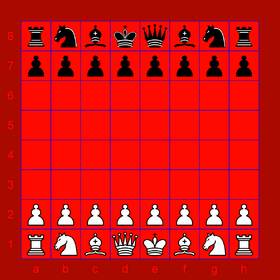Senterej
Senterej (Amharic ሰንጠረዥ sänṭäräž or Ethiopian chess) is a regional chess variant, the form of chess traditionally played in Ethiopia and Eritrea. It is the last popular survival of shatranj.[1][2] A distinctive feature of Senterej is the opening phase – players make as many moves as they like without regard for how many moves the opponent has made; this continues until the first capture is made. Memorization of opening lines is therefore not a feature of the game.

Rules
Pieces
Broadly, the pieces move the same way as in shatranj; however, there are regional variations.












We notice that the possible movements of the main senterej pieces, excluding that of the king and pawn, are complementary to one another, occupying, without any omission or redundancy, all available squares with regards to a central position inside a 5x5 grid, as shown in the figure to the right.[3]
Gameplay
In Senterej both sides start playing at the same time without waiting for turns. The phase before first capture is called the "mobilization" or "marshalling" phase, or werera. Both players may move their pieces as many times as they like without concern for the number of moves the opponent makes. During this phase the players watch each other's moves, and retract their own and substitute others as they think best. They only start to take turns after the first capture.
The object of the game is to checkmate the opponent. A king denuded of all pieces (excluding pawns) cannot be mated; the game is drawn. A king with only a single piece supporting him (again excluding pawns) can only be mated before that piece has moved seven times, or else the game is drawn.[4]
Customs
Traditionally, the board is not checkered, merely marked into squares; it is usually a red cloth, marked by strips of black or blue. The play is much more sociable than is usual in Western chess, with all the bystanders (even, formerly, slaves) calling out their notions of useful plays and moving the pieces about to demonstrate. The customs surrounding checkmate are numerous. Dealing the fatal blow with a rook or knight is considered inartistic. Delivering the fatal stroke with a ferz or fil is more respectable; with a combination of pawns, even more praiseworthy.
References
- Pritchard, D. B. (2007). Beasley, John (ed.). The Classified Encyclopedia of Chess Variants. John Beasley. p. 247. ISBN 978-0-9555168-0-1.
- Pritchard, D. B. (1994). The Encyclopedia of Chess Variants. Games & Puzzles Publications. p. 104. ISBN 0-9524142-0-1.
- Something similar also holds for both modern chess (rook-knight-bishop and knight-queen), as well as Tamerlane chess (general-vizier-elephant-catapult-knight and rook-general-knight-camel-giraffe).
- This account of the rules is taken from Murray, H. J. R., A History of Chess, Oxford University Press, Oxford, 1913, pp. 362–64.
External links
- Senterej, the Ethiopian Chess
- Senterej – Ethiopian chess with a flying start by Dr. René Gralla
- A Note on Ethiopian Chess by Dr. Richard Pankhurst
- Kaiserin setzte ein Korps matt (Neues Deutschland) (in German)
- Ethiopian Chess a simple program by Ed Friedlander (Java)